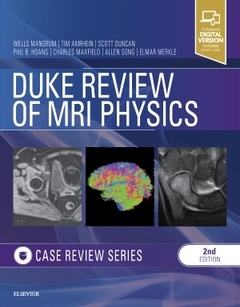Description
Duke Review of MRI Physics: Case Review Series (2nd Ed.)
Case Review Series
Authors: Mangrum Wells, Hoang Quoc Bao, Amrhein Tim J, Duncan Scott M, Maxfield Charles M, Merkle Elmar, Song Allen W
Language: English
Subject for Duke Review of MRI Physics: Case Review Series:
76.21 €
In Print (Delivery period: 14 days).
Add to cart264 p. · 21.5x27.6 cm · Paperback
Description
/li>Contents
/li>
A solid understanding of MRI physics is essential for both residents and practicing radiologists, and Duke Review of MRI Physics Principles: Case Review Series, 2nd Edition, provides practical applications, board-style self-assessment questions, and clinically relevant cases in a high-yield, easy-to-digest format. Designed to help you solve clinical questions, arrive at accurate diagnoses, and use MRI more effectively in your practice, it uses a case-based approach to demonstrate the basic physics of MRI and how it applies to successful and accurate imaging, interpretation, and diagnosis.
- Focuses on 18 key MRI principles (such as T1 contrast, T2 contrast, and proton density), using a series of cases that make difficult concepts engaging and understandable.
- Features over800 high-quality MR images in a full-color, user-friendly case format with clear explanations of physics and other MRI principles.
- Shares the experience and knowledge of a multidisciplinary author team comprising radiology residents, practicing radiologists, and radiology physicists who provide practical guidance for each body system - neurologic, breast, body, vascular, and musculoskeletal.
- Includes a new chapter on MRI Safety, as well as new and improved color images in functional MRI, perfusion MRI, and diffusion tensor imaging.
- Contains more than 300 all-new multiple-choice self-assessment questions following the board review certification and recertification question format.
- Includes new Take-Home-Points at the end of each chapter for easy recall and review.
- Expert ConsultT eBook version included with purchase. This enhanced eBook experience allows you to search all of the text, figures, and references from the book on a variety of devices.
2. T2 Contrast
3. Proton Density
4. Gadolinium-Based Contrast Agents
5. Preparatory Pulses
6. Inversion Recovery
7. Chemical Shift Type 2 Artifact
8. Susceptibility Artifact
9. Motion, Pulsation, and Other Artifacts
10. Flow-Related Contrast
11. Time-of-Flight Imaging
12. Time-Resolved Contrast-Enhanced Magnetic Resonance Angiography
13. Phase Contrast
14. Diffusion MRI
15. Perfusion Magnetic Resonance Imaging
16. Magnetic Resonance Spectroscopy
17. Functional Magnetic Resonance Imaging
18. MRI Safety
These books may interest you

MRI in Practice 48.15 €



